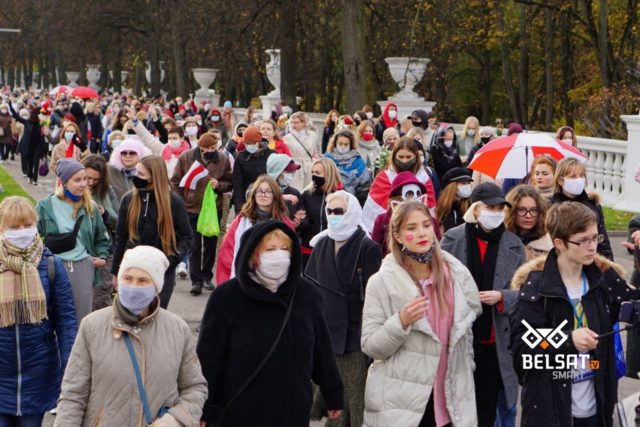
A Belarusian Revolution? What Kind? (Part Two)
Publication: Eurasia Daily Monitor Volume: 17 Issue: 156
By:

*To read Part One, please click here.
The protest movement under way in Belarus appears to the world as yet another “color revolution” for “regime change.” The target this time is the autocracy of President Alyaksandr Lukashenka, following the rigged presidential election on August 9 and disproportionate use of force against protesters from then to date. This movement differs from Central-Eastern Europe’s previous “color revolutions” in a number of fundamental ways, including the “bourgeois” class makeup of the protesters, the unique socio-economic system cultivated by Lukashenka, the popular social welfare aspects of Lukashenka’s “paternalistic authoritarianism,” relative lack of systemic corruption or “oligarchs” in Belarus, and absence of a popular desire among the protesters to take the country Westward (see Part One in EDM, November 2).
The sixth key difference in the Belarusian case is the unprecedented fact of this “color revolution” originating in several Russia-oriented political projects—namely, the presidential candidacies of Viktar Babarika (head of Gazprombank’s Belarusian branch), Valery Tsepkalo (former official with long-standing Moscow connections), and Siarhei Tsikhanousky (“Russian World”–sympathizing blogger). Moscow had counted on these political projects to destabilize Lukashenka in the post-election period, before presenting the disobedient (presumably still reelected) president with the next “integration ultimatum.” The elite candidates Babarika and Tsepkalo had shown themselves open to Russian “integration” proposals; while the otherwise impecunious Tsikhanousky seemed sufficiently funded for his campaign to attract Lukashenka’s working-class voters. Moscow also sent a group of 33 Wagner Group mercenaries to trouble the post-election waters in Belarus. With Babarika and Tsikhanousky arrested and Tsepkalo fleeing to Moscow, it befell the spouses, Sviatlana Tsikhanouskaya and Veranika Tsepkalo, along with Babarika’s chief of staff Mariya Kalesnikava, to assume the nominal leadership of the post-election protest movement. They unified their respective staffs under Tsikhanouskaya as figurehead (Ethz.ch, pp. 3–4, October 2020; see EDM, July 30, August 3, September 10).
Seventh, and uniquely again, the Belarusian “color revolution” seeks to remove a president who has staunchly resisted the country’s integration with Russia (while extracting resources from it and seeking rapprochement with the West at the same time). By contrast, all the previous movements for regime change in Central-Eastern Europe had opposed Russia-friendly governments (or governments too ineffective to resist Russian influence). Unlike those previous movements, the current Belarusian opposition cannot and does not depict the incumbent government as pro-Russian, nor does it see Russia as endangering Belarus’s sovereignty. Instead, opposition leaders who remain free and moved abroad seek Moscow’s intercession in some mediating role in Belarus’s internal politics (see EDM, September 30, October 1, November 2).
Eighth, Moscow abandoned the political projects associated with Babarika, Tsepkalo and Siarhei Tsikhanousky as soon as their Coordinating Committee became tainted with a “color revolution”—that is, within days of the August 9 election. The spontaneous mass movement overtook and overwhelmed the Coordinating Committee, rendering its members unusable by Moscow because: a) the Kremlin abhors the potentially contagious effect of regime-change movements from below, its own modus operandi being controlled destabilization; b) the Coordinating Committee failed to bring the spontaneous mass protests under its control; c) the Committee adopted members not controlled or approved by Moscow and not Russia-oriented; and d) the Committee was soon decimated by arrests or the forced emigration of its members. Instead, Moscow shifted gears tactically to shore up Lukashenka on a temporary basis, and conditional on an orderly regime change under Russian arbitration. Moscow’s abandonment of the Coordinating Committee made possible a Western interception of what had started as a Russian project (see below). Ironically, it is the West, not Moscow, calling for the release of Russia-connected figures such as Babarika and Siarhei Tsikhanousky (along with many in no way connected with Russia) from prison in Belarus (see EDM, September 16, October 7, 8).
Ninth, Belarus seems to be the only case in which a “color revolution” broke out without any kind of Western-assisted preparations. Western organizations only knew the Belarusian “old political opposition” and had basically de-funded it in recent years. Once the protest movement broke out and state repressions forced some Coordinating Committee members to move abroad, the West embraced them along with the anti-Lukashenka regime-change agenda. Sviatlana Tsikhanouskaya in Lithuania is the most conspicuous case of a successful interception of a political project.
Tenth, exceptionally in the history of East-Central Europe’s “color revolutions,” the Belarusian movement is not concerned with repudiating the historic Russian Empire and the Soviet Union. This sets the current movement apart even from the Belarusian “old opposition” of the last 30 years. Nor does the current protest movement raise the issues of promoting the Belarusian national identity and language to the level of political demands (this was a focus of the “old opposition,” some of whose members have joined the current movement). The white-red-white flag seems rather to fulfil the need for a symbol of defiance to the authorities (see EDM, November 3); the demonstrators who carry that flag in Minsk usually speak Russian among themselves as a matter of course. And although public spaces in Minsk and the entire country abound in Soviet imagery (monuments, place names, symbols of all kinds), this movement is not raising political demands for de-Sovietization of public spaces (neighboring Ukraine was the last country to embark on this policy after 2014).



